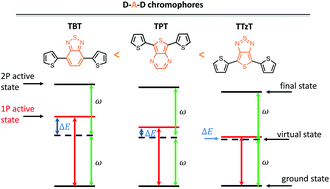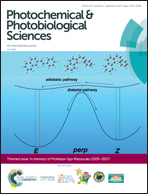One- and two-photon absorption properties of quadrupolar thiophene-based dyes with acceptors of varying strengths†
Abstract
The one-photon (1P) and two-photon (2P) absorption properties of three quadrupolar dyes, featuring thiophene as a donor and acceptors of varying strengths, are determined by a combination of experimental and computational methods employing the density functional theory (DFT). The emission shifts in different solvents are well reproduced by time-dependent DFT calculations with the linear response and state specific approaches in the framework of the polarizable continuum model. The calculations show that the energies of both 1P- and 2P-active states decrease with an increase of the strength of the acceptor. The 2P absorption cross-sections predicted by the response theory are accounted for by considering just one intermediate state (S1) in the sum-over-states formulation. For the chromophore featuring the stronger acceptor, the energetic positions of the 1P- and 2P-active states prevent the exploitation of the theoretically predicted very high 2P activity due to the competing 1P absorption into the S1 state.

- This article is part of the themed collection: In memory of Professor Ugo Mazzucato (1929–2017)


 Please wait while we load your content...
Please wait while we load your content...